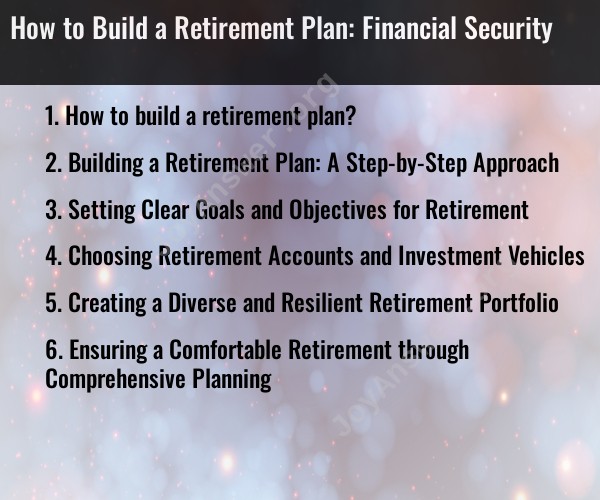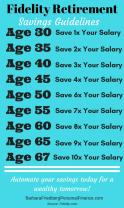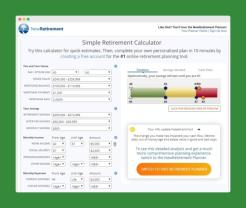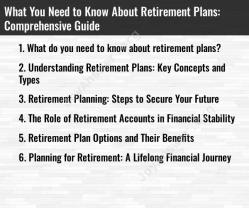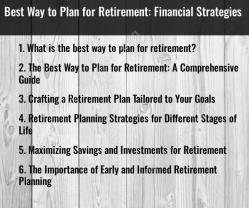How to build a retirement plan?
Building a retirement plan is crucial for achieving financial security during your post-working years. Here are the steps to help you create a comprehensive retirement plan:
Set Retirement Goals:
- Determine your retirement age and the lifestyle you want during retirement. Consider factors like where you want to live, travel plans, healthcare needs, and any hobbies or activities you want to pursue.
Calculate Retirement Expenses:
- Estimate your retirement expenses, including housing, healthcare, daily living, entertainment, and any other costs. Don't forget to account for inflation.
Assess Current Financial Situation:
- Evaluate your current financial situation, including savings, investments, and existing retirement accounts. Calculate your net worth.
Determine Retirement Income Sources:
- Identify potential sources of retirement income, such as Social Security, pensions, annuities, and any other guaranteed income streams.
Set a Savings Target:
- Calculate how much you need to save to achieve your retirement goals. Online retirement calculators can help with this. Consider working with a financial advisor to get a more accurate estimate.
Create a Retirement Savings Plan:
- Develop a strategy for saving and investing for retirement. This may include contributions to retirement accounts like 401(k)s, IRAs, or employer-sponsored plans.
Invest Wisely:
- Diversify your investments to manage risk. Consider a mix of stocks, bonds, and other assets that align with your risk tolerance and time horizon.
Maximize Retirement Accounts:
- Contribute the maximum allowable amount to retirement accounts each year. Take advantage of employer matches in 401(k) plans if available.
Debt Management:
- Pay down high-interest debts before retirement. Reducing your debt load can free up more of your retirement income for living expenses.
Emergency Fund:
- Maintain an emergency fund to cover unexpected expenses, so you don't have to tap into your retirement savings prematurely.
Healthcare Planning:
- Ensure you have a plan for healthcare coverage during retirement. Consider long-term care insurance if necessary.
Regularly Review and Adjust:
- Periodically review your retirement plan to ensure you are on track to meet your goals. Adjust your savings and investment strategies as needed.
Social Security Strategy:
- Understand when it's best to start taking Social Security benefits. Delaying can increase your benefit amount.
Estate Planning:
- Create or update your estate plan to ensure your assets are distributed according to your wishes.
Retirement Income Strategies:
- Develop a strategy for generating income during retirement, such as withdrawing from your retirement accounts in a tax-efficient manner.
Consider Part-Time Work:
- Think about whether part-time work during retirement is an option, as it can provide additional income and keep you engaged.
Seek Professional Guidance:
- Consult with a financial advisor or retirement specialist to help you navigate complex financial decisions and ensure your retirement plan is optimized for your individual situation.
Remember that building a retirement plan is an ongoing process. Life circumstances change, and your plan may need adjustments along the way. Starting early and being consistent in your savings and investment efforts can greatly enhance your financial security in retirement.
Building a Retirement Plan: A Step-by-Step Approach
Building a retirement plan is an important part of financial planning. It can help you to ensure that you have enough money to live comfortably in retirement.
Here is a step-by-step approach to building a retirement plan:
- Set clear goals and objectives for retirement. What do you want to do in retirement? What kind of lifestyle do you want to have? How much money do you need to support your desired lifestyle? Once you have a good understanding of your retirement goals, you can start to develop a plan to achieve them.
- Choose retirement accounts and investment vehicles. There are a variety of retirement accounts and investment vehicles available. Choose options that are right for your financial situation and risk tolerance. Some popular retirement accounts include 401(k)s, IRAs, and SEP IRAs. Some popular investment vehicles include stocks, bonds, and mutual funds.
- Create a diverse and resilient retirement portfolio. A diverse portfolio is one that includes a variety of different investments. This can help to reduce your risk if one investment performs poorly. A resilient portfolio is one that can withstand market downturns.
- Rebalance your portfolio regularly. As you get closer to retirement, you may want to rebalance your portfolio to reduce your risk. Rebalancing involves selling some of your more aggressive investments and buying more conservative investments.
- Monitor your progress and make adjustments as needed. It is important to monitor your progress and make adjustments to your retirement plan as needed. Your financial situation and goals may change over time, so it is important to keep your plan up-to-date.
Setting Clear Goals and Objectives for Retirement
When setting goals and objectives for retirement, it is important to consider the following factors:
- Your desired lifestyle in retirement. Do you want to travel extensively? Downsize your home? Move to a warmer climate?
- Your income needs in retirement. How much money do you need to cover your basic living expenses, such as housing, food, and transportation? How much money do you need for discretionary expenses, such as travel and entertainment?
- Your risk tolerance. How much risk are you comfortable with when investing for retirement?
- Your time horizon. When do you plan to retire? How long do you think you will live in retirement?
Once you have considered these factors, you can start to set specific goals and objectives for your retirement. For example, you might set a goal of having $1 million saved by the time you retire. Or, you might set a goal of being able to generate $50,000 in annual income from your retirement savings.
Choosing Retirement Accounts and Investment Vehicles
There are a variety of retirement accounts and investment vehicles available. Choose options that are right for your financial situation and risk tolerance.
Some popular retirement accounts include:
- 401(k)s: 401(k)s are employer-sponsored retirement savings plans. Employees can contribute a portion of their paycheck to their 401(k) account. Employers may also match employee contributions up to a certain percentage.
- IRAs: Individual retirement accounts (IRAs) are retirement savings plans that can be opened by individuals. There are two main types of IRAs: traditional IRAs and Roth IRAs. Traditional IRAs offer tax-deductible contributions and tax-deferred growth. Roth IRAs offer after-tax contributions and tax-free growth.
- SEP IRAs: Simplified employee pension (SEP) IRAs are retirement savings plans that can be opened by self-employed individuals and small businesses. SEP IRAs offer high contribution limits and tax-deductible contributions.
Some popular investment vehicles include:
- Stocks: Stocks represent ownership in a company. Stocks can be a risky investment, but they have the potential to generate high returns over the long term.
- Bonds: Bonds are loans that investors make to companies or governments. Bonds are generally less risky than stocks, but they also offer lower returns.
- Mutual funds: Mutual funds are baskets of stocks and/or bonds. Mutual funds can be a good way to diversify your portfolio and reduce your risk.
Creating a Diverse and Resilient Retirement Portfolio
A diverse portfolio is one that includes a variety of different investments. This can help to reduce your risk if one investment performs poorly.
A resilient portfolio is one that can withstand market downturns. To create a resilient portfolio, you may want to include a mix of stocks, bonds, and cash.
Ensuring a Comfortable Retirement through Comprehensive Planning
Retirement planning is more than just choosing retirement accounts and investment vehicles. It is also important to consider other factors, such as your health insurance needs and your estate plan.
To ensure a comfortable retirement, it is important to create a comprehensive plan that addresses all of your needs.
